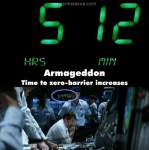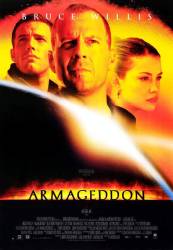Factual error: The idea of two spacecraft blasting off together so close to each other at the same time is a joke. One would put the other at great risk. Not only is there massive fire and heat, but the vibrations from the noise of the exhaust do great damage to the surroundings. And there is great inconsistency about just how close the two spacecraft really are. The first still shot taken in the dark has them at different towers about 150 yards apart. But, then all the men take an elevator up ONE tower and are split apart into the two groups at the top of the tower. Furthermore, the launch takes place at Kennedy Space Center Launch Complex 39: the fixed and rotating service structures built for the Space Shuttle are visible. The pads at LC 39 are 8,700 feet apart (just over 1.5 miles). (01:00:00)
Factual error: The surviving space shuttle takes off from the asteroid horizontally, like an airliner taking off from a runway. This is absurd. There is no air to provide lift for the wings, so the shuttle - with its engines providing thrust straight back - would simply trundle along the ground like a car. It doesn't use its maneuvering jets at any time, and they are far too feeble to lift the weight of the shuttle anyway. Nor do they gimbal the main engine, which would lift the shuttle vertically on an axis through the centre of the engine - they swoop gracefully into the air after a long take off. Second, they'd have to count on finding a clear length of ground on a debris strewn asteroid. Vertical takeoff, anyone?
Factual error: During the scene where it shows people all over the world, just before the shuttles take off, it is daylight everywhere. It would actually be dark or near dark in parts of the world.

Factual error: After crashing on the asteroid, A.J. walks outside surveying the wreckage while debris is strewn out burning on the ground. This is wrong, as oxygen is needed to make something burn, and there is no oxygen on the asteroid. (01:27:40)
Factual error: Okay, we know the astronauts can walk around on the asteroid because they have those thrusters. So how is it, then, that the pilot can walk around the shuttle without anything to keep her on the ground? She should be bouncing around like the moon walkers.
Factual error: When A.J. starts up the Armadillo to jump the canyon, you can hear the sound of big, internal combustion engines. The Armadillo must have electric engines in order to function in the vacuum of space. Electric engines are virtually silent. (01:47:55)
Factual error: The shuttle crews are taking on liquid oxygen from the Russian space station. During their briefing, Truman refers to the oxygen as their fuel. Oxygen is not the fuel; oxygen is the oxidizer. The fuel is liquid hydrogen. (00:41:35)
Other mistake: A.J. gets dirt on his face although he is covered by an astronaut's suit.
Factual error: En route to the asteroid, the two space shuttles head to the Russian space station to refuel. To simulate gravity, the cosmonaut aboard the space station fires a few rockets to put the space station into the spin. How fast does it need to spin to reproduce Earth gravity? Assuming the space station's spoke arms (where the shuttles dock) are about 50 feet long, the answer is 8 revolutions a minute. That makes it impossible to dock - it'd be like trying to drive a car on ice-covered roads into a spinning parking garage. There's another, more fundamental, problem: the artificial gravity points in the wrong direction. Think of spinning rides at the amusement park. The spinning motion creates an artificial gravity, an effective outward-pushing force. On the space station, the spinning would tend to throw the astronauts down the station's spoke arms and back onto the shuttle. Also, the artificial gravity would taper off to nothing at the centre. But the movie's artificial gravity somehow points down, not outward, and appears to work equally well throughout the station.
Factual error: Earlier in the film the mission coordinator says that they are going to experience 9.5G's for 11 min. Untrained astronauts would not be able to even maintain consciousness, let alone be talking and yelling as they do in this scene. (01:22:00 - 01:24:00)
Factual error: During the movie's opening scene, you watch the asteroid that killed the dinosaurs some 65 million years hitting Earth near the Caribbean (you can see Cuba and Yucatan). 65 million years ago, Earth's continents were in different locations and most of the Caribbean looked very different.
Factual error: In the scene with the "lunar roll" (where both shuttles Freedom and Independence are being sling-shot around the moon), they are said to be experiencing "9 and a half G's for 11 minutes". But during this time, the crew members are screaming at the top of their lungs at each other. Under that much pressure it would be nearly impossible to breathe, let alone scream. Even if they're wearing G-suits, with the helmets off, they would be directly exposed to the pressure. (01:18:50)
Suggested correction: Common misconception on the effects of high G on the body. The reason why we see pilots in videos struggling to breath is not the high G, but the breathing technique they use to fight off the blood pressure drop and avoid G-loc. High G only effects are pulling the face down, making the head extremely heavy, and eventually loss of consciousness (G-loc). Also, any mention of pressure is irrelevant, as acceleration (high G) and pressure are two completely unrelated topics.
It sounds like you're saying without proper breathing techniques, they would have experienced "G-loc." So if the crew is talking/yelling and not properly breathing, they should have experienced "G-loc." And I don't know who taught you math and science, but Pressure = Force/Area. And Force = Mass x Acceleration. So pressure is 100% related to acceleration and G's.
Factual error: In the Russian space station, A.J. and Lev are running to the Independence shuttle. But as the space station is falling apart, a piece of it crashes into the other end of the hallway they are currently running through. There is no way they would make it to the shuttle even with it being a few feet away; they'd get sucked out into space almost immediately.
Factual error: When Oscar Choi is talking to A.J. about "Star Wars," A.J. is measuring something with a dial indicator, but he is holding it like a micrometer. A dial indicator needs to be fixed to something to measure how far the arm moves from your work piece. (00:39:50)
Factual error: After the shuttles drop their boosters and again after they fire their retros they bank and turn in space like fighters do in the atmosphere. Spacecraft don't move that way. They don't corner like a racing car. (01:08:00)
Factual error: It's explained in detail how the impact will cause a horrible freak tide, what it will do, and that one half of mankind will die in the nuclear winter. That's absolutely irrelevant. The asteroid is "the size of Texas," that means a quarter of a million square miles. Such an impact is called ELE (Extinction Level Event). A bigger part of the Pacific Ocean would evaporate immediately, so no matter if a wave or not. The earth would become "sterilized." So no lifeform will live long enough to die in a winter. (So it is nonsensical to compare that impact with the event 65 million years ago. It's much different).

Continuity mistake: After Sharpe and Stamper have the argument on the asteroid, Truman says they need the radio back up. When he says this, you see the countdown clock for the asteroid which is at five hours and 12 minutes. A bit later in the film, after the nuke was shut down by a technician at NASA, one of the Air Force Sergeants takes the terminal. In the background, you can see the clock again but the time on it is at six hours and 49 minutes. (01:37:00 - 01:42:50)
Factual error: When drilling you have to remove the debris. This is usually done with some sort of liquid as an agent and supporting machinery. As the asteroid has some gravity the debris won't just flow into space. No machinery/liquid to be found anywhere.
Continuity mistake: When in the Russian space station, AJ is in a little pit fixing something. When we see him, he has a little snow hat. The next time he has nothing on. Then back again with the little hat.
Continuity mistake: At the end of the movie, after the asteroid explodes, we see Grace looking through the glass and there are reflections of NASA controllers cheering. The same shot was used earlier in the film to depict Grace looking upset at some bad news. The camera zoomed into the picture a bit, but you can still see one controller cheering.





